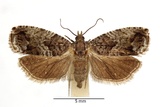Cydia fagiglandana (Zeller, 1841) Species
Last modified: Nov. 24, 2025, 7:59 p.m.
A common species throughout Belgium.
Details
- Classification
- Family: Tortricidae > Subfamily: Olethreutinae > Tribus: Grapholitini > Genus: Cydia > Species: Cydia fagiglandana
- Vernacular names
- Beukenspiegelmot (NL), Beech Mast Piercer, Large Beech Piercer (EN), Buchenwickler (DE)
- Synonyms
- Cydia grossana (Haworth, 1811), nec (Thunberg, 1791) and Cydia aspidiscana sensu auct.
- First mention in Belgium
- De Sélys-Longchamps E. 1844. Énumération des insectes Lépidoptères de la Belgique. — Mémoires de la Société royale des Sciences de Liége 2: 1–35. On page 21.
- Status
-
Native
Distribution
Imago
Wingspan 13–19 mm. Similar to Cydia splendana, but with rather less contrast between light and dark. It has a more uniformly grey general appearance and show a more striated pattern of the forewing.
The basal third is usually darker towards the dorsum and the ocellar area may also be edged darker but not as strongly black as in Cydia splendana.
Bionomics
The larva bores into the nuts and feeds inside the nuts of the host plant. When the nuts fall, it vacates the nut and constructs a cocoon in which it hibernates. Hibernation occurs as a late instar larva. The larval stage may last for two years. Usually only one larva is found per fruit. Pupation takes place in a cocoon spun in the soil, in litter, in rotten wood or under bark or moss.
The moths are active in the evening and later come to light.
Flight periods
The adults have been observed from May till the end of September. Most observations during June/July.
Observed on
- Host plant (species):
- Fagus sylvatica
The larva feeds on Fagus sylvatica. Any information about other plants is uncertain and probably incorrect.
Habitat
It inhabits beech woodland or places with stands of beech like parks etc...










